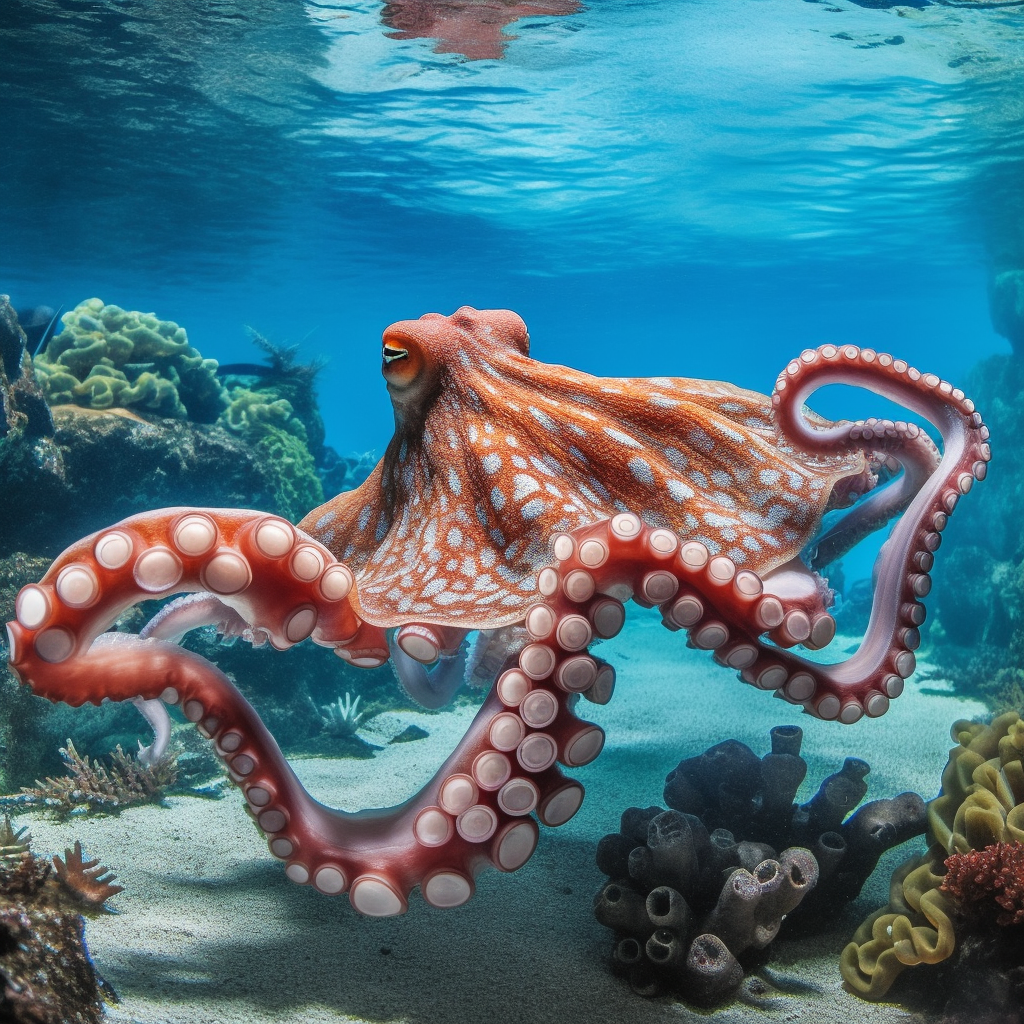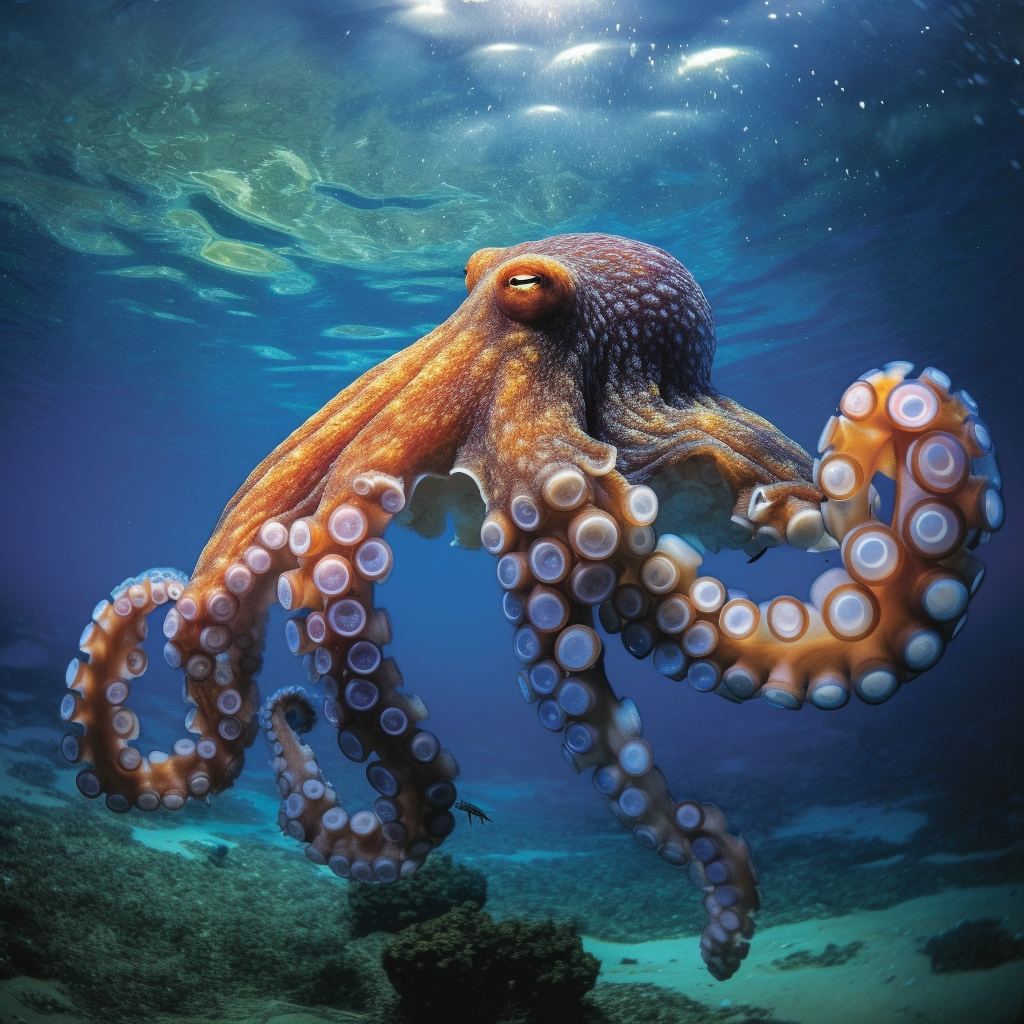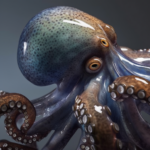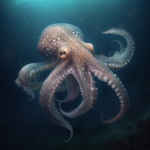The giant Pacific octopus, scientifically known as Enteroctopus dofleini, is a fascinating creature that inhabits the waters of the Pacific Ocean. As one of the largest species of octopus, it boasts an impressive size and a voracious appetite. In this article, we will explore the dietary habits of the giant Pacific octopus, delving into the types of food it consumes and how it captures its prey. From crabs and clams to fish and even other octopuses, this magnificent creature has a diverse and varied diet that showcases its adaptability and hunting prowess. So, let’s dive into the underwater world of the giant Pacific octopus and discover what fuels its remarkable existence.
Key Takeaways
- Giant Pacific octopuses are opportunistic predators and have a diverse diet.
- Their diet includes crustaceans, mollusks, fish, and even other octopuses.
- They are known to be skilled hunters and can use their intelligence to catch prey.
- Their feeding habits can vary depending on their size, location, and availability of food.
- Understanding their diet is important for their conservation and management.
Understanding the Giant Pacific Octopus

A. What is a Giant Pacific Octopus?
The Giant Pacific Octopus, scientifically known as Enteroctopus dofleini, is a fascinating creature that inhabits the Pacific Ocean. As its name suggests, this octopus is the largest of its kind, with some individuals reaching lengths of up to 16 feet and weighing over 100 pounds. These magnificent cephalopods are known for their intelligence, adaptability, and unique hunting abilities.
Giant Pacific Octopuses are part of the cephalopod family, which also includes squids and cuttlefish. They have a soft body, eight long arms, and a large bulbous head. Their skin is covered in chromatophores, specialized cells that allow them to change color and texture to blend in with their surroundings. This remarkable camouflage helps them avoid predators and ambush their prey.
B. How Smart are Giant Pacific Octopuses?
Giant Pacific Octopuses are highly intelligent creatures. They have a well-developed nervous system and a large brain, making them one of the most intelligent invertebrates. Their problem-solving skills and ability to learn from experience have astounded scientists and researchers.
These octopuses have a remarkable memory and can recognize individuals, including humans. They can also solve complex puzzles and open jars to access food. In captivity, they have been observed using tools and manipulating objects, showcasing their cognitive abilities.
Their intelligence is further demonstrated by their hunting techniques. Giant Pacific Octopuses are skilled predators, using their strong beak-like mouth to capture and consume their prey. They have a diverse diet, feeding on a variety of marine creatures such as crustaceans, mollusks, and fish. Their feeding habits play a crucial role in maintaining the balance of the underwater food chain.
In the next section, we will delve deeper into the diet of the Giant Pacific Octopus and explore the fascinating world of its underwater culinary preferences. The Diet of the Giant Pacific Octopus
The giant Pacific octopus, known scientifically as Enteroctopus dofleini, is a fascinating creature that resides in the Pacific Ocean. As one of the largest octopus species, it has a voracious appetite and a diverse diet. In this section, we will explore what these magnificent creatures eat, how they consume their prey, and how often they feed.
A. What Do Giant Pacific Octopuses Eat?
Giant Pacific octopuses are skilled predators, capable of hunting a wide range of sea creatures. Their diet primarily consists of crustaceans, mollusks, and other cephalopods. Let’s take a closer look at some of the specific food sources that make up their diet:
-
Shellfish: The giant Pacific octopus has a particular affinity for shellfish, such as clams and crabs. With their powerful beak, they can easily crack open the shells to access the soft flesh inside. This ability allows them to take advantage of the abundance of these prey items in their habitat.
-
Fish: While not their primary food source, giant Pacific octopuses have been known to prey on small fish when the opportunity arises. They use their incredible camouflage skills to ambush unsuspecting fish that swim too close.
-
Other Invertebrates: In addition to shellfish and fish, these octopuses also feed on a variety of other invertebrates, including sea urchins, snails, and worms. Their flexible bodies and dexterous tentacles enable them to capture and consume these prey items with ease.
-
Crustaceans: Crustaceans, such as shrimp and lobsters, are also on the menu for giant Pacific octopuses. These creatures provide a nutritious meal and are often found in the same habitats as the octopuses, making them easily accessible.
It’s important to note that the diet of a giant Pacific octopus can vary depending on factors such as its location, the availability of prey, and individual preferences. These adaptable creatures are opportunistic feeders, taking advantage of whatever food sources are readily available in their environment.
B. How Do Giant Pacific Octopuses Eat?
The giant Pacific octopus employs a unique feeding strategy to consume its prey. When hunting, it uses its powerful tentacles to capture its target and bring it close to its beak. The beak, located at the center of its tentacles, is used to break open shells and tear apart the flesh of its prey.
Once the prey is within reach, the octopus uses its radula, a rough, tongue-like structure, to scrape off any edible parts. This allows the octopus to extract as much nutrition as possible from its meal. The remaining indigestible parts, such as shells or bones, are discarded.
C. How Often Does the Giant Pacific Octopus Eat?
The feeding frequency of giant Pacific octopuses can vary depending on factors such as their size, age, and reproductive status. Generally, these octopuses have a high metabolic rate and require regular meals to sustain their energy levels.
During periods of active growth and reproduction, giant Pacific octopuses tend to eat more frequently. For example, a female octopus preparing to lay eggs may increase her food intake to provide the necessary energy for egg production. On the other hand, after laying eggs, the female‘s appetite decreases significantly, and she may even stop eating altogether until the eggs hatch.
In general, giant Pacific octopuses feed opportunistically, taking advantage of available prey whenever it presents itself. They are skilled hunters and have been observed using various hunting techniques, including ambushes and stealthy approaches.
In conclusion, the giant Pacific octopus has a diverse diet that includes shellfish, fish, other invertebrates, and crustaceans. They use their powerful beaks and tentacles to capture and consume their prey, while their radula helps extract the edible parts. The feeding frequency of these octopuses can vary depending on factors such as their size, age, and reproductive status. Overall, their diet and feeding habits play a crucial role in the intricate underwater food chain of the Pacific Ocean.
The Predatory Nature of the Giant Pacific Octopus
The giant Pacific octopus, known scientifically as Enteroctopus dofleini, is a fascinating creature that inhabits the waters of the Pacific Ocean. With its impressive size and intelligence, it is no surprise that this octopus is a formidable predator. Let’s explore the predatory nature of the giant Pacific octopus and answer some intriguing questions about its diet.
A. Do Giant Pacific Octopuses Eat Sharks?
When it comes to the question of whether giant Pacific octopuses eat sharks, the answer is no. Sharks are powerful and agile predators themselves, and they are not typically on the menu for these octopuses. While the giant Pacific octopus is an apex predator in its own right, it primarily focuses on smaller prey that is more within its grasp.
B. What Sharks Do Giant Pacific Octopuses Eat?
Although giant Pacific octopuses do not typically prey on sharks, they may occasionally scavenge on the remains of dead sharks that have sunk to the ocean floor. As opportunistic feeders, they are known to take advantage of any available food source. However, it is important to note that this behavior is not a primary part of their diet.
C. Do Giant Pacific Octopuses Eat Humans?
The idea of a giant Pacific octopus feasting on humans may sound like something out of a science fiction movie, but in reality, it is highly unlikely. These octopuses are not known to actively seek out humans as prey. They are generally shy and elusive creatures, preferring to avoid human interaction altogether.
While the giant Pacific octopus is a powerful predator, its diet primarily consists of a variety of marine creatures found in its habitat. Let’s take a closer look at some of the common prey items that make up the octopus’s diet.
1. Crustaceans
Crustaceans, such as crabs and lobsters, are a favorite food source for the giant Pacific octopus. With their strong beak-like mouth, octopuses can easily crack open the shells of these creatures to access the tasty meat inside. They use their dexterous tentacles to capture and manipulate their prey, making quick work of their meal.
2. Mollusks
Mollusks, including clams, mussels, and snails, are another important part of the giant Pacific octopus’s diet. These soft-bodied creatures are abundant in the octopus’s habitat and provide a good source of nutrition. The octopus uses its suction cups to grasp onto the shells of these mollusks, prying them open with its beak to access the flesh inside.
3. Fish
While fish may not be the primary prey for giant Pacific octopuses, they do occasionally target smaller species of fish that venture too close. With their lightning-fast reflexes and camouflage abilities, octopuses can surprise their prey and capture them with their powerful tentacles. Fish provide a valuable source of protein and nutrients for these intelligent creatures.
4. Other Cephalopods
As fellow members of the cephalopod family, it is not uncommon for giant Pacific octopuses to prey on other cephalopods, such as squid. These creatures are well-equipped for hunting and have a similar set of skills and adaptations. Octopuses may engage in fierce battles with their cephalopod counterparts, using their strength and intelligence to secure a meal.
In conclusion, the giant Pacific octopus is a skilled and opportunistic predator that feeds on a variety of marine prey. While it does not typically eat sharks or pose a threat to humans, it is an important part of the underwater food chain. By understanding the diet and feeding habits of the giant Pacific octopus, we can gain a deeper appreciation for the intricate balance of the aquatic ecosystem.
The Value and Cost of the Giant Pacific Octopus

A. How Much Does a Giant Pacific Octopus Cost?
The giant Pacific octopus is a fascinating creature that captivates the imagination of many. Its unique appearance and intelligent behavior make it a highly sought-after species in the world of marine enthusiasts and collectors. However, acquiring a giant Pacific octopus comes with a price.
The cost of a giant Pacific octopus can vary depending on several factors. One of the main factors that influence the price is the size of the octopus. Smaller individuals are generally more affordable, while larger specimens can command a higher price due to their rarity and impressive presence.
Another factor that affects the cost is the source of the octopus. Octopuses caught in the wild tend to be more expensive than those bred in captivity. This is because capturing wild octopuses requires specialized equipment and expertise, making it a more labor-intensive and costly process.
Furthermore, the availability of giant Pacific octopuses can also impact their price. If the supply is limited, the demand increases, driving up the cost. Conversely, if there is an abundance of octopuses available, the price may be more affordable.
B. How Much is a Giant Pacific Octopus?
The price of a giant Pacific octopus can range anywhere from a few hundred dollars to several thousand dollars. Smaller individuals, measuring around one to two feet in length, can be found at the lower end of the price spectrum. These smaller octopuses are often more affordable for hobbyists and individuals looking to keep them as pets.
On the other hand, larger specimens, measuring three feet or more, can be significantly more expensive. These majestic creatures are highly sought after by public aquariums and educational institutions due to their impressive size and captivating presence. As a result, the price for a large giant Pacific octopus can reach several thousand dollars.
It’s important to note that the cost of a giant Pacific octopus is not solely determined by its size. Other factors, such as the octopus’s health, temperament, and overall condition, can also influence its price. Additionally, the reputation and location of the seller can play a role in determining the cost.
In conclusion, the value and cost of a giant Pacific octopus can vary depending on factors such as size, source, availability, and demand. Whether you’re a marine enthusiast, a collector, or an educational institution, acquiring a giant Pacific octopus can be a rewarding and awe-inspiring experience. However, it’s essential to consider the responsibilities and requirements involved in caring for these magnificent creatures before making a purchase.
The Edibility of the Giant Pacific Octopus
The giant Pacific octopus, known scientifically as Enteroctopus dofleini, is a fascinating creature that inhabits the waters of the Pacific Ocean. While it may be intriguing to learn about what the giant Pacific octopus eats, another common question that arises is whether or not it is safe for human consumption. In this section, we will explore the edibility of the giant Pacific octopus and shed light on this intriguing topic.
Can You Eat Giant Pacific Octopus?
The short answer is yes, you can eat giant Pacific octopus. However, there are a few factors to consider before indulging in this delicacy. Let’s take a closer look at what makes the giant Pacific octopus edible and how it is prepared for consumption.
Sustainability and Regulations
Before harvesting or consuming any marine creature, it is essential to consider sustainability and adhere to local regulations. The giant Pacific octopus is a valuable part of the marine ecosystem, and overfishing can have detrimental effects on its population. It is crucial to ensure that the octopus is caught sustainably and within legal limits to protect its population and the overall health of the ocean.
Culinary Delight
The giant Pacific octopus is highly regarded for its culinary appeal. Its meat is tender, flavorful, and versatile, making it a sought-after ingredient in various cuisines. Chefs around the world appreciate the unique texture and taste of octopus meat, which can be prepared in a multitude of ways, including grilling, boiling, or braising.
Preparation and Cooking
When it comes to preparing giant Pacific octopus for consumption, proper cleaning and cooking techniques are essential. The octopus needs to be thoroughly cleaned to remove any residual sand or debris. The most common method involves blanching the octopus in boiling water for a few minutes and then submerging it in ice water to stop the cooking process. This helps to tenderize the meat and enhance its flavor.
Once cleaned, the octopus can be cooked using various methods, depending on personal preference. Grilling octopus imparts a smoky flavor and creates a slightly charred exterior, while boiling or braising results in a more tender and succulent texture. Octopus can be incorporated into salads, stews, or even served as a standalone dish.
Culinary Cultures
Different cultures have their own unique ways of preparing and enjoying giant Pacific octopus. In Japan, for example, octopus is a popular ingredient in sushi and sashimi. In Mediterranean cuisine, grilled octopus is a beloved delicacy. Whether it’s in a hearty Spanish octopus stew or a Korean octopus stir-fry, this fascinating creature has found its way into the hearts and palates of people around the world.
In conclusion, while the giant Pacific octopus is indeed edible, it is crucial to consider sustainability, adhere to regulations, and follow proper cleaning and cooking techniques. With its tender meat and versatility in the kitchen, the giant Pacific octopus offers a unique culinary experience for those willing to explore the depths of the ocean‘s bounty. So, if you ever have the opportunity to try this intriguing delicacy, be sure to savor the flavors and appreciate the wonders of the sea.
The Reproduction of the Giant Pacific Octopus

The Giant Pacific Octopus, also known as Enteroctopus dofleini, is a fascinating creature that inhabits the waters of the Pacific Ocean. In this section, we will explore how these incredible cephalopods reproduce.
A. How Does the Giant Pacific Octopus Reproduce?
The reproductive process of the Giant Pacific Octopus is truly remarkable. Unlike many other species, these octopuses have a relatively short lifespan, typically living for only three to five years. However, during this time, they go through an incredible journey of reproduction.
-
Mating: The mating process of the Giant Pacific Octopus begins when a male and female encounter each other. The male octopus uses one of his specialized arms, called a hectocotylus, to transfer a packet of sperm, known as a spermatophore, into the female‘s body. This process can take several hours and is a crucial step in the reproduction cycle.
-
Egg Laying: After mating, the female octopus will lay thousands of small, gelatinous eggs. These eggs are typically attached to a hard surface, such as rocks or the walls of a den. The female will diligently guard and care for the eggs, ensuring their survival.
-
Brooding Period: During the brooding period, which can last anywhere from one to several months, the female octopus remains with her eggs, protecting them from predators and ensuring they receive adequate oxygen. This dedicated maternal behavior is essential for the survival of the offspring.
-
Hatching: Once the eggs are ready to hatch, the female octopus will gently blow water over them, providing the necessary oxygen for the developing embryos. The hatching process can take several hours, and once the tiny octopuses emerge, they are left to fend for themselves.
It’s important to note that the reproductive cycle of the Giant Pacific Octopus is a one-time event for the female. After laying and caring for her eggs, she will eventually succumb to exhaustion and die. However, her legacy lives on through her offspring, who will continue the cycle of life.
In conclusion, the reproduction of the Giant Pacific Octopus is a fascinating process that showcases the incredible resilience and dedication of these marine creatures. From mating to egg laying and brooding, every step in their reproductive journey is essential for the survival of the species. Understanding the intricacies of their reproduction helps us appreciate the remarkable nature of these intelligent and mysterious creatures. Conclusion
In conclusion, the giant Pacific octopus is a fascinating creature with a diverse diet. These intelligent cephalopods are opportunistic hunters and will eat a wide range of prey, including crustaceans, fish, and even other octopuses. They have a remarkable ability to adapt their feeding habits to their surroundings, using their powerful beak to crack open shells and their flexible bodies to squeeze into tight spaces in search of food. While they primarily rely on their excellent camouflage and stealth to catch their prey, they are also known to scavenge for food and have been observed stealing catches from fishermen’s traps. The giant Pacific octopus truly is a formidable predator of the ocean, and its diet reflects its adaptability and resourcefulness.
Frequently Asked Questions
1. What do Giant Pacific Octopus eat?
Giant Pacific Octopuses have a diverse diet. They primarily feed on crustaceans, mollusks, and a variety of sea creatures. This includes shellfish and other marine life species found in the Pacific Ocean.
2. How do Giant Pacific Octopuses eat?
Giant Pacific Octopuses are skilled hunters. They use their strong arms and suction cups to catch prey. Once caught, they drill into shells with their beak to consume the soft parts of their prey.
3. Can you eat Giant Pacific Octopus?
Yes, Giant Pacific Octopus is edible and is often used in various cuisines worldwide. However, it’s important to ensure it is cooked properly to avoid potential health risks.
4. How often does the Giant Pacific Octopus eat?
The feeding habits of the Giant Pacific Octopus can vary based on factors like availability of prey and the octopus’s size and age. However, they typically eat several times a day.
5. What sharks do Giant Pacific Octopuses eat?
While the Giant Pacific Octopus is a formidable predator, it does not typically prey on sharks. They mainly feed on smaller marine creatures like crustaceans and mollusks.
6. Do Giant Pacific Octopuses eat sharks?
While there have been rare instances of Giant Pacific Octopuses attacking and eating small sharks, it is not a common part of their diet. They primarily feed on smaller sea creatures.
7. Do Giant Pacific Octopuses eat humans?
No, Giant Pacific Octopuses do not eat humans. While they are large and powerful creatures, they are not known to be a threat to humans unless provoked.
8. How smart are Giant Pacific Octopuses?
Giant Pacific Octopuses are considered one of the most intelligent invertebrates. They have been observed using tools, escaping from enclosures, and showing problem-solving abilities.
9. How does the Giant Pacific Octopus reproduce?
Giant Pacific Octopuses reproduce by the male octopus inserting a specialized arm called a hectocotylus into the female‘s mantle cavity to deposit spermatophores. The female then lays thousands of eggs and guards them until they hatch.
10. How much does a Giant Pacific Octopus cost?
The cost of a Giant Pacific Octopus can vary widely based on factors like size, age, and where it is purchased. It’s best to contact a reputable aquarium or marine life dealer for specific pricing information.




